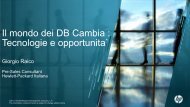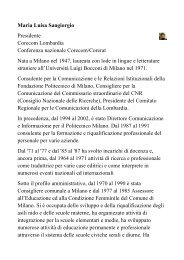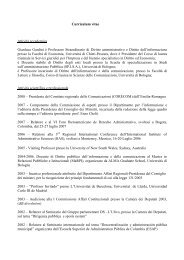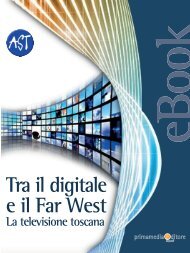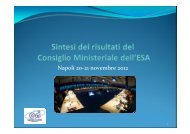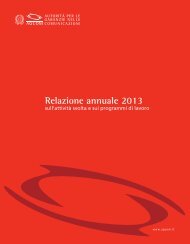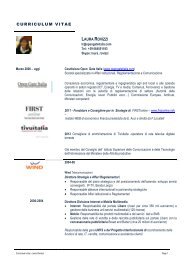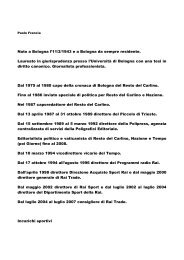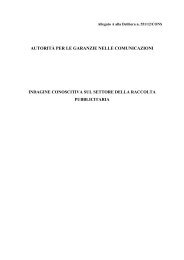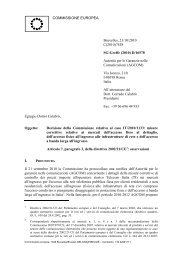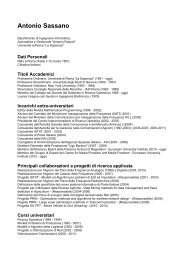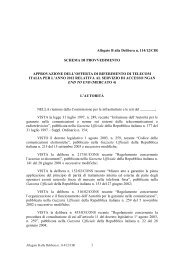The ResearchModel <strong>and</strong>Glossary of KeyTermsBased on the results of a survey completedby over 225 technology leaders, representingfirms from North America, Europe <strong>and</strong> the Asia-Pacific region <strong>and</strong> from a variety of industrialsectors, this report discusses the potentialbusiness value of three important technologies,namely mobility, cloud-based services,<strong>and</strong> unified communications <strong>and</strong> unifiedcommunications <strong>and</strong> collaboration platforms(collaboration tools). The work focuses on thefactors – what we call “key business enablers”– than enable organizations to achieve higherreturns on their investments in these threetechnologies.Figure 1 represents the research model <strong>and</strong> thetypes of data that were collected. The modelbuilds on the most relevant <strong>and</strong> latest academicliterature about the relationship betweentechnology <strong>and</strong> business performance. Inaddition to collecting survey data, severalChief Information Officers of leading Europeanmultinationals were interviewed. Throughoutthis report, their insights into how they usetechnology to enhance business performance<strong>and</strong> competitiveness are summarized in shortcase studies, titled “Real Successes.”Several key terms related to the researchmodel are used in this report to describe theresearch findings. Below, they are summarizedfor easy reference. In subsequent sectionsbeginning <strong>with</strong> the title “Definition,” the termsare described in greater detail.Three types of information <strong>and</strong>communication technologies (<strong>ICT</strong>)Mobility refers to the usage of portable devicesconnecting to the Internet through mobiletelephone networks. Portable devices refer toportable computers: notebooks, netbooks,laptops, Ultra Mobile PC-UMPCs, tablet PCs; aswell as portable devices such as Smartphones<strong>and</strong> customized PDA phones.Cloud-based services have the followingcharacteristics: pay per use; external resourcepooling; rapid scalability; flexibility; <strong>and</strong>ubiquitous network access. They includesoftware-as-a-service; platform-as-a-service;infrastructure-as-a-service; <strong>and</strong> businessprocess-as-a-service.Collaboration tools merge multiple toolsincluding instant messaging, conferencing,email <strong>and</strong> unified messaging to teamcollaboration <strong>and</strong> voice calling <strong>with</strong> presencebehind a single user interface – easily accessiblefrom almost any device <strong>and</strong> from virtuallyanywhere – to increase personal productivity<strong>and</strong> business efficiency in ways no single toolever could before. collaboration tools mayconsist of tele-presence, web conferencing,messaging, <strong>and</strong> voice.High Investors <strong>and</strong> Low InvestorsOne of the key distinguishing variables that wasexamined was the percentage of the total <strong>ICT</strong>budget that a firm spent on each of the threetypes of technology: mobility, cloud-basedservices; <strong>and</strong> collaboration tools.• High Investors in Mobility: firms that spentmore than 10% of their total <strong>ICT</strong> budgeton Mobility;• High Investors in Cloud-based services:firms that spent more than 10% of theirtotal <strong>ICT</strong> budget on Cloud-based services;• High Investors in collaboration tools: firmsthat spent more than 10% of their total <strong>ICT</strong>budget on collaboration tools; <strong>and</strong>• Low Investors: firms that spent less than10% of their total <strong>ICT</strong> budget on a giventype or types of technology.It is important to note that investmentsin mobility, cloud-based services, <strong>and</strong>collaboration tools are not mutually exclusive,<strong>with</strong> some solutions involving one, two or evenall three technologies.Strong <strong>Business</strong> EnablersThe research focused on four key businessenablers. The results reveal that strong businessenablers are critical to increasing the likelihoodof high performance <strong>and</strong> mitigating the risks ofwasting investments in <strong>ICT</strong>. The enablers are:• Strong business involvement: firms<strong>with</strong> sufficient participation by businessunit managers <strong>and</strong> senior executives intechnology investment <strong>and</strong> managementdecisions;• Sufficient technology-focused talent:firms <strong>with</strong> sufficient access to peoplewho can perform well in predominantlytechnical activities;• Sufficient management-focused talent:firms <strong>with</strong> sufficient access to peoplewho can perform well in predominantlymanagerial activities; <strong>and</strong>• Mature digitized platform: firms <strong>with</strong>efficient levels of st<strong>and</strong>ardization <strong>and</strong>sharing across their organization in termsof technology, business processes <strong>and</strong>data.High Performers <strong>and</strong> Low PerformersAt the end of the day, business leaders want toknow what the best performing firms are doing<strong>and</strong> how they are outperforming their peers.The research focused on 20 performanceindicators, representing three general aspectsof business performance: business processperformance, agility, <strong>and</strong> organizational change<strong>and</strong> performance. High performers are firmsthat perform better than average <strong>with</strong> regardsto a single performance indicator or a set ofperformance indicators.Figure 1: Survey data were collected on firm investments <strong>and</strong> uses of technology, key enablers, <strong>and</strong> a variety ofperformance indicators.Firm CharacteristicsINvestments in <strong>ICT</strong>What types of <strong>ICT</strong>:• Mobility• Cloud• Unified Communications <strong>and</strong>Collaboration (UCC)+xkey enablers &constraints<strong>Business</strong> InvolvementAccess to Talent• Management-focused• Technology-focusedDigitized Platform Maturity• <strong>ICT</strong>• <strong>Business</strong> Process• Data=<strong>Business</strong> Process <strong>Performance</strong>Agilityproductivity &competitvenessOrganizational Change &<strong>Performance</strong>6 INSEAD eLab <strong>ICT</strong> Report
FindingUses of technologycan become a doubleedgedswordOrganizations are continuously learning how touse technology to operate <strong>and</strong> innovate moreeffectively <strong>and</strong> efficiently. A few examples froman annual award recognizing Europe’s bestChief Information Officers (CIOs) illustrate howorganizations are using technology to enhancetheir performance. 1José Manuel Inchausti, CIO of MAPFRE, aleading insurance company in Spain <strong>and</strong>Latin America, introduced an integrated dataplatform to enable business units <strong>with</strong>inMAPFRE to engage <strong>with</strong> customers througha variety of channels in a consistent <strong>and</strong>coordinated manner. In the process, Inchaustideveloped business <strong>and</strong> customer intelligence.Furthermore, smarter analysis of existingcompany data enabled Inchausti <strong>and</strong> his teamto better underst<strong>and</strong> why specific clients wereunhappy <strong>with</strong> their insurance policies <strong>and</strong> as aresult the business units were able to developeffective retention strategies.At the Coca-Cola Company, Europe CIO SabineEveraet <strong>and</strong> her IT team of 45 <strong>ICT</strong> specialistsh<strong>and</strong>le all non-outsourced <strong>ICT</strong> needs in Europe.For a global firm that generated revenues ofmore than EUR 46.5 billion in 2011, Everaet <strong>and</strong>her group are considered key business partnersfor identifying risks <strong>and</strong> interdependencies forcomplex programs, <strong>with</strong> a scope well beyondthat of the classical IT projects. They earnedtheir enhanced strategic roles only afterimproving <strong>ICT</strong> operations <strong>and</strong> enhancing keybusiness processes.In 2009, when Pieter Schoehuijs became theCIO of Akzo Nobel, the largest decorativepaints <strong>and</strong> performance coatings company inthe world, the Dutch firm was suffering fromuncoordinated <strong>ICT</strong> development. 2 With 15separate business units, Akzo Nobel had “avery diverse systems l<strong>and</strong>scape <strong>with</strong> literallythous<strong>and</strong>s of systems on even more servers,”Schoehuijs said. Instead of implementing asingle instance of an enterprise resourcesplanning (ERP) system across the entire firm,Schoehuijs decided to support six differentsystems to give individual business units greateragility. Said Schoehuijs, “When I joined threeyears ago, Akzo Nobel had 183 ERP systems.Today we have 96. And we’ve establishedroadmaps <strong>and</strong> strategy plans to go to six.Which means that in the last three years wehave retired more than two ERP systems permonth on average, <strong>and</strong> we are planning tocontinue to do so for the next four years.” 3By rapidly harmonizing both <strong>ICT</strong> systems <strong>and</strong>business processes, Schoehuijs has reducedAkzo Nobel’s operation costs <strong>and</strong> enhancedthe customer experience.This research report strives tounderst<strong>and</strong> how successful firms cantake advantage of new technologieswhile mitigating any risks associated<strong>with</strong> such investments.However, uses of technology can becomea double-edged sword—it can enableopportunities but can also introduce risks.Uses of technology enable organizations toconnect <strong>and</strong> engage <strong>with</strong> their stakeholders innew <strong>and</strong> significantly faster <strong>and</strong> cheaper ways.As a result, organizations can have access toimportant resources <strong>with</strong>out necessarily havingto own them, for example, through businessprocesses outsourcing. However in theprocess of connecting <strong>and</strong> engaging, uses oftechnology introduce new interdependenciesthat, if improperly managed, can lead to costly<strong>and</strong> inefficient operations <strong>and</strong> can ultimatelyreduce agility <strong>and</strong> hurt performance.1Fonstad, N. (2012). 2012 IT Enabled Leadership Report.2By 2011, each business unit generated 1bn EUR on average, for a total of 15.7bn EUR.3Fonstad 2012: p. 19.<strong>Building</strong> <strong>Business</strong> <strong>Performance</strong> <strong>and</strong> <strong>Competitiveness</strong> <strong>with</strong> <strong>ICT</strong>7



